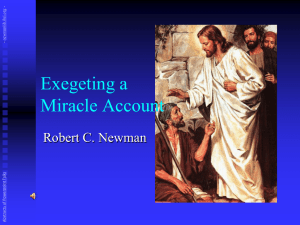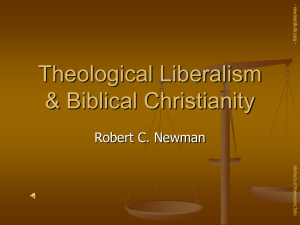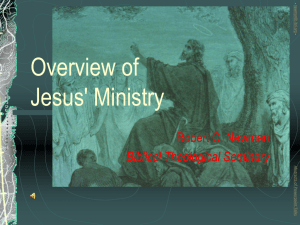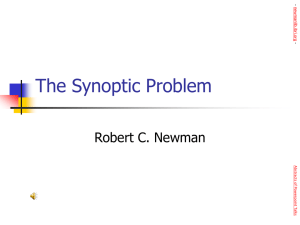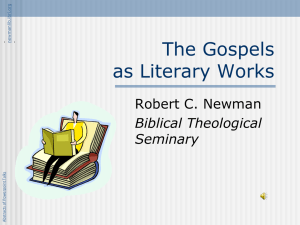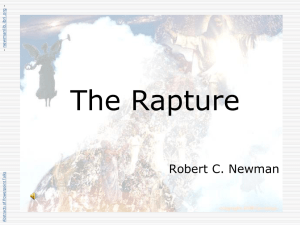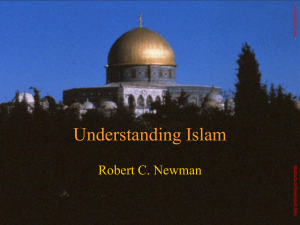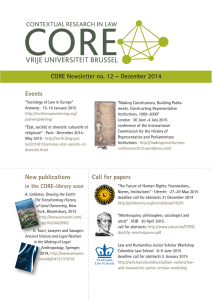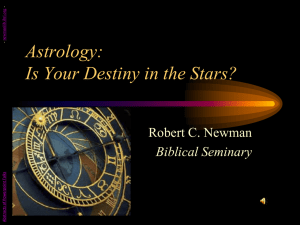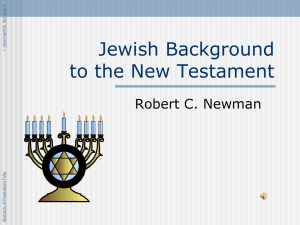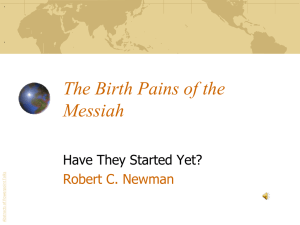Genesis One & the Origin of the Earth
advertisement
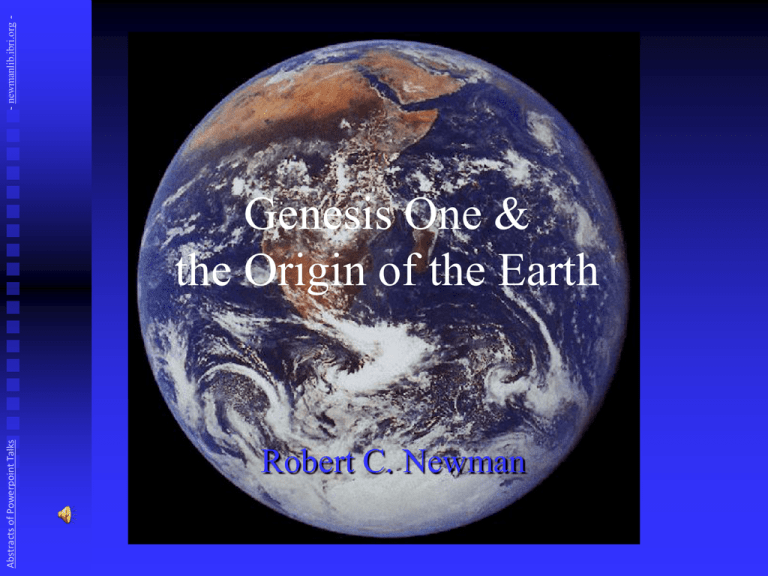
- newmanlib.ibri.org Abstracts of Powerpoint Talks Genesis One & the Origin of the Earth Robert C. Newman - newmanlib.ibri.org - Origin of the Earth Abstracts of Powerpoint Talks Recent advances have aided our understanding: Improved optical telescopes Space probes Computer power Better techniques for detecting planets As a result, now have considerable evidence for testing origin theories. - newmanlib.ibri.org - Genesis One Abstracts of Powerpoint Talks Bible written over 2000 years ago, when humans had no way to study universe as we do now. Can such a book really tell us anything about earth's origin? Bible claims to come from earth's Creator. Abstracts of Powerpoint Talks Scientific Data - newmanlib.ibri.org - - newmanlib.ibri.org - Scientific Data Abstracts of Powerpoint Talks Mass distribution Angular momentum distribution Shape of orbits Alignment of orbits Chemical composition of planets - newmanlib.ibri.org - Mass Distribution Mass not evenly distributed. Most of mass concentrated in sun. The distribution is: Sun 750 parts Rest 1 part Abstracts of Powerpoint Talks - newmanlib.ibri.org - Angular Momentum: What? Abstracts of Powerpoint Talks Linear momentum – tendency to move in straight line. Angular momentum – tendency to keep rotating. Both depend on object's speed & mass. Both kinds need force to change them. - newmanlib.ibri.org - Angular Momentum Distribution Abstracts of Powerpoint Talks Angular momentum of solar system not evenly distributed Distributed quite differently than mass Distribution: Sun has 1 part Planets 200 parts - newmanlib.ibri.org - Planetary Orbits Abstracts of Powerpoint Talks Planets move in nearly circular orbits rather than elongated ones. They all go around the sun in the same direction. Their orbital planes nearly coincide with that of the sun's equator. - newmanlib.ibri.org - Chemical Composition Abstracts of Powerpoint Talks Planets have the same elements as sun and earth, but in very different proportions. The inner planets form one group: Small Heavy Non-volatile The outer planets form another: Large Light Volatile Abstracts of Powerpoint Talks Scientific Models - newmanlib.ibri.org - - newmanlib.ibri.org - Random Capture Models Abstracts of Powerpoint Talks Velikovsky, Patten are proponents. Planets formed elsewhere, captured by sun. Compare novel When Worlds Collide. This gives randomly oriented, non-circular orbits. - newmanlib.ibri.org - Close-Approach Models Abstracts of Powerpoint Talks Chamberlain, Moulton, Jeans are proponents. Near-collision between stars Tidal forces pulled out gas, formed planets Gives co-planar orbits, but not circular Not likely to form planets Rare in any case - newmanlib.ibri.org - Star-Formation Models Abstracts of Powerpoint Talks Kant, Laplace, Gold, Hoyle are proponents. Planets are a natural by-product of star-formation under certain conditions. This model is generally favored today. It naturally explains features of mass, angular momentum, orbit & composition mentioned earlier. It predicts planets will be relatively common, now known to be the case. Let's examine this model in some detail. - newmanlib.ibri.org - Starts with a Gas Cloud Abstracts of Powerpoint Talks Spiral galaxies have gas & dust clouds. These contain mostly H and He with 1% heavier elements as dust or ices. These clouds are very diffuse, a few atoms per cubic centimeter. Some are rather hot (1000 oK), others rather cold (100 oK). - newmanlib.ibri.org - Collapsing Gas Cloud Abstracts of Powerpoint Talks Sometimes a gas cloud will begin to collapse. Cooler, denser clouds more likely A jolt may start it. Once cloud begins to collapse, it will typically continue. - newmanlib.ibri.org - Rotating Gas Cloud Abstracts of Powerpoint Talks Random motions in the cloud will cancel, leaving only movement & rotation. The rotation will be highly magnified as the collapse continues. This would typically produce a pancake shape unless other forces intervene. - newmanlib.ibri.org - Other Forces If rotation is too fast, the cloud will split, forming two or more stars, but probably few or no planets. As the cloud collapses, it will get hotter and denser, especially near its center. This will eventually ionize the gas, bringing in an additional force, electro-magnetism. Abstracts of Powerpoint Talks - newmanlib.ibri.org - Ionized Cloud Abstracts of Powerpoint Talks This new force will split the cloud into two regimes: Central bulge sun Outer band planets Magnetic forces will connect these regions. - newmanlib.ibri.org - Formation of Planetesimals Abstracts of Powerpoint Talks As outer band picks up angular momentum, it moves away from center and cools. The various chemicals condense out, the nonvolatiles in close, the volatiles further out. This band will form the planets, rotating in the same direction as the sun. - newmanlib.ibri.org - Formation of Planets Abstracts of Powerpoint Talks The planetesimals collide & adhere to form larger objects. They gradually sweep up all the solid materials in the region. The final collisions are violent, involving much larger objects. This produces irregularities in orbits & rotation. - newmanlib.ibri.org - Formation of Planets The inner planets are formed from close-in material, so less volatile; there is less of this, so planets are small. The outer planets are formed from outer materials, so more volatile; there is more of this, so planets are larger. The planets form cold, but heat up from radioactivity, pressure and collisions. Abstracts of Powerpoint Talks - newmanlib.ibri.org - Formation of Atmospheres Abstracts of Powerpoint Talks The outer planets collect gases from nearby. The inner planets lose this sort of gas due to heat of sun & less gravity. The inner planets get their atmosphere from inside as the planet heats and loses its volatiles originally adsorbed on dust & ice grains. - newmanlib.ibri.org - Review of Star-Formation Model Abstracts of Powerpoint Talks Shapeless, empty gas cloud begins to collapse. It becomes hotter & denser as it collapses. Rotation makes the cloud flatten. Ionization splits cloud into flat band & rounded center. Band gains angular momentum. The band moves outward, cools and condenses. - newmanlib.ibri.org - Review of Model Abstracts of Powerpoint Talks Condensing ices & dust first form planetesimals, then planets. The planets rotate around sun in one plane aligned with sun's equator, revolving in same direction as sun. Interior radioactive decay, pressure & meteor bombardment heat the inner planets, driving out gases inside. - newmanlib.ibri.org - Evidence for This Theory It fits the data sketched above, as it was designed to do. No other does as well. It also explains irregularities in this data. It predicts that planets will be common, as now seems to be the case. It predicts that planet formation is still going on, as also seems to be so. Abstracts of Powerpoint Talks Abstracts of Powerpoint Talks Biblical Data - newmanlib.ibri.org - - newmanlib.ibri.org - Fit with Genesis One? This model doesn't seem to fit very well with the traditional interpretation. But the traditional interpretation was made by people who didn't know the science. It doesn't follow that the model doesn't fit with what the Genesis account actually says. Let's see. Abstracts of Powerpoint Talks - newmanlib.ibri.org - Fit with Genesis One Abstracts of Powerpoint Talks We will look at what the Biblical text says in the Hebrew. We will try to see if it can be understood in harmony with solid scientific data, since God is author of both nature and Scripture. - newmanlib.ibri.org Abstracts of Powerpoint Talks Genesis 1:1-5 In the beginning God created the heavens and the earth. Now the earth was formless and empty, darkness was over the surface of the deep, and the Spirit of God was hovering over the waters. And God said, "Let there be light," and there was light. God saw that the light was good, and he separated the light from the darkness. God called the light "day," and the darkness he called "night." And there was evening, and there was morning – one day. - newmanlib.ibri.org - Genesis 1:1-5 Abstracts of Powerpoint Talks A beginning when God created The earth initially formless & empty; solar system formed from amorphous gas cloud. Darkness; as the cloud collapses, it becomes denser, darker. Cloud begins to glow as it ionizes. Equatorial band pushed outside glow. Rotating planets have day/night sequence. - newmanlib.ibri.org Abstracts of Powerpoint Talks Genesis 1:6-8 And God said, "Let there be an expanse between the waters to separate water from water." So God made the expanse and separated the water under the expanse from the water above it. And it was so. God called the expanse "sky." And there was evening, and there was morning – a second day. - newmanlib.ibri.org - Genesis 1:6-8 Abstracts of Powerpoint Talks An expanse is formed to separate the waters — the atmosphere. This expanse forms our blue sky; no need to see it as a solid dome. No need to have the waters "above" be outside our atmosphere. The order fits the scientific view re/ outgassing. - newmanlib.ibri.org - Job 38:8-9 Abstracts of Powerpoint Talks Who shut up the sea behind doors when it burst forth from the womb, when I made the clouds its garment and wrapped it in thick darkness? - newmanlib.ibri.org - Job 38:8-9 God is here speaking to Job in poetic language about the birth of the oceans. The womb is apparently the earth, just as the scientific outgassing model suggests. The earth was then cloud-covered and dark, suggesting (when harmonized with Genesis one) the simultaneous formation of atmosphere and ocean. Abstracts of Powerpoint Talks - newmanlib.ibri.org - Genesis 1:9-10 Abstracts of Powerpoint Talks And God said, "Let the water under the sky be gathered to one place, and let dry ground appear." And it was so. God called the dry ground "land" and the gathered water "seas." And God saw that it was good. - newmanlib.ibri.org - Genesis 1:9-10 Abstracts of Powerpoint Talks We now know that earth's surface is great, thin plates of crust, moving slowly on the mantle beneath. There are two types of crust: Light, thick continent Heavy, thin ocean basin It looks like the oceans drained off into the basins when the crust split into two kinds. - newmanlib.ibri.org Abstracts of Powerpoint Talks Genesis 1:11-13 Then God said, "Let the land produce vegetation: seed-bearing plants and trees on the land that bear fruit with seed in it, according to their various kinds." And it was so. The land produced vegetation… And God saw that it was good. And there was evening, and there was morning – a third day. - newmanlib.ibri.org - Genesis 1:11-13 Abstracts of Powerpoint Talks Naturally, there is no land vegetation without land to have it on. The order is interesting here: Plants are narrated before animals, which depend on them. Plants are narrated before sun, moon & stars, seen as contradicting science. But something more subtle is going on here. - newmanlib.ibri.org Abstracts of Powerpoint Talks Genesis 1:14-19 And God said, "Let there be lights in the expanse of the sky to separate the day from the night, and let them serve as signs to mark seasons and days and years. And let them be lights in the expanse of the sky to give light upon the earth." And it was so. God made two great lights – the greater light to dominate the day and the lesser light to dominate the night. He also made the stars. God set them in the expanse of the sky to give light on the earth, to dominate the day and the night, and to separate light from darkness. And God saw that it was good. And there was evening, and there was morning – a fourth day. - newmanlib.ibri.org - Genesis 1:14-19 Abstracts of Powerpoint Talks Though often overlooked, this fits science very well. Viewed from earth, this describes the clearing of the atmosphere so that sun, moon & stars become visible. This clearing is the direct result of vegetation, which removes carbon dioxide and replaces it with oxygen. - newmanlib.ibri.org - Synthesis Abstracts of Powerpoint Talks In the beginning God created heaven & earth. A beginning – the big bang, perhaps. Earth is formless & empty. Earth an amorphous, tenuous gas cloud. Darkness on the face of the deep. After contraction, cloud becomes dark. Let there be light. Further contraction & cloud begins to glow. - newmanlib.ibri.org - Synthesis Abstracts of Powerpoint Talks Light divided from darkness Planetary material thrust outside. Light = day, darkness = night Planet formed from planetesimals. Sun & rotation give day & night. Waters burst forth from womb of earth, expanse appears in midst of waters. Heating earth drives out water & gases. - newmanlib.ibri.org - Synthesis Division of waters above & below Atmosphere allows both surface & atmospheric water. Gathering of waters, dry land appears. Development of continental crust. Earth brings forth vegetation. Land vegetation appears. Abstracts of Powerpoint Talks - newmanlib.ibri.org - Synthesis Abstracts of Powerpoint Talks Lights appear in sky to mark off days, seasons & years; sun & moon dominate day & night. Photosynthesis by vegetation replaces CO2 by oxygen, lowering temperature & clearing atmosphere so stars, etc. visible; also prepares atmosphere for animals and humans. - newmanlib.ibri.org - Genesis One & Origin of Earth A reasonable interpretation of biblical & scientific data is consistent in a striking, non-trivial way. The correlation between Genesis 1 & science is much better than between Genesis & other ancient creation accounts. We suggest this is so because the Creator is the author of Genesis. Abstracts of Powerpoint Talks - newmanlib.ibri.org - For Further Reading Abstracts of Powerpoint Talks Newman & Eckelmann, Genesis One & the Origin of the Earth John Wiester, The Genesis Connection Hugh Ross, The Creator & the Cosmos
